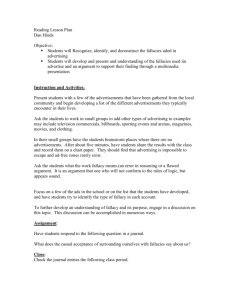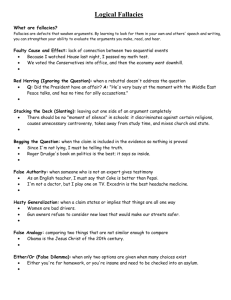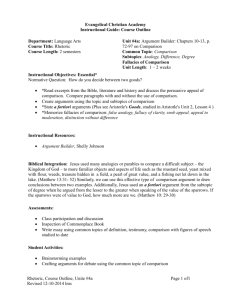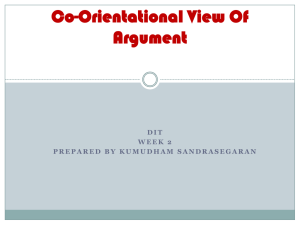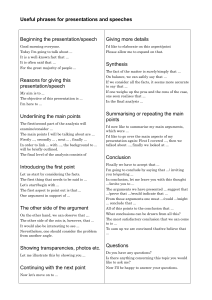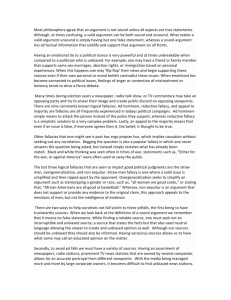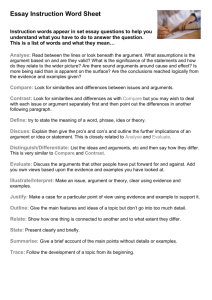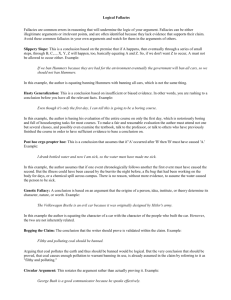Monty Python and the Quest for the Perfect Fallacy
advertisement
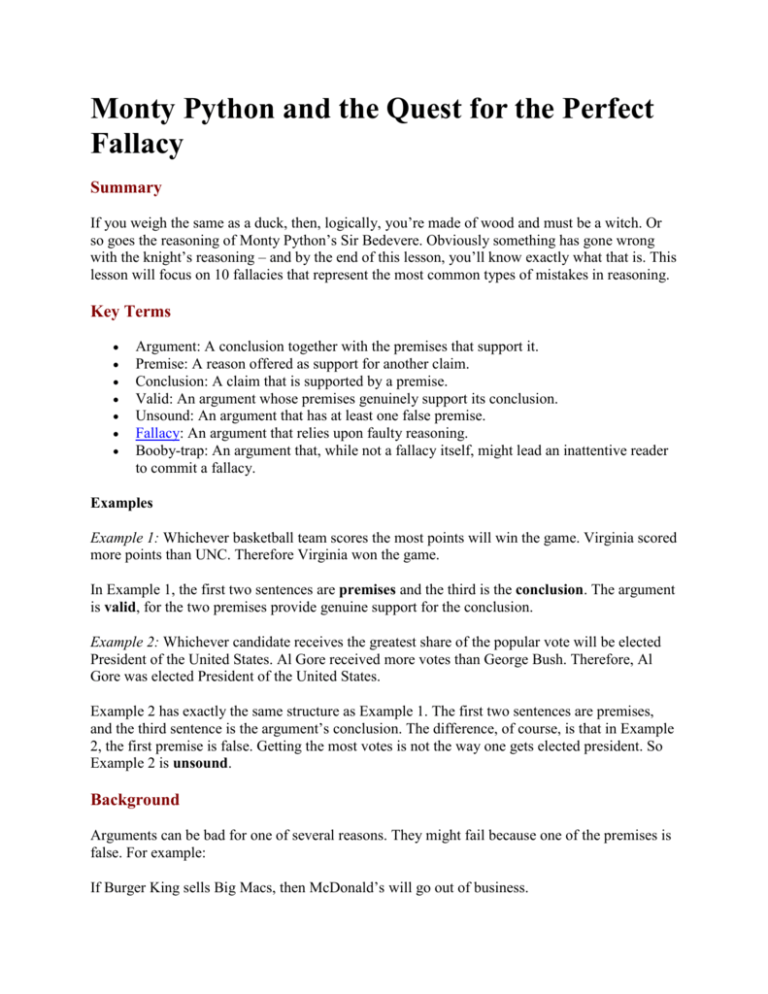
Monty Python and the Quest for the Perfect Fallacy Summary If you weigh the same as a duck, then, logically, you’re made of wood and must be a witch. Or so goes the reasoning of Monty Python’s Sir Bedevere. Obviously something has gone wrong with the knight’s reasoning – and by the end of this lesson, you’ll know exactly what that is. This lesson will focus on 10 fallacies that represent the most common types of mistakes in reasoning. Key Terms Argument: A conclusion together with the premises that support it. Premise: A reason offered as support for another claim. Conclusion: A claim that is supported by a premise. Valid: An argument whose premises genuinely support its conclusion. Unsound: An argument that has at least one false premise. Fallacy: An argument that relies upon faulty reasoning. Booby-trap: An argument that, while not a fallacy itself, might lead an inattentive reader to commit a fallacy. Examples Example 1: Whichever basketball team scores the most points will win the game. Virginia scored more points than UNC. Therefore Virginia won the game. In Example 1, the first two sentences are premises and the third is the conclusion. The argument is valid, for the two premises provide genuine support for the conclusion. Example 2: Whichever candidate receives the greatest share of the popular vote will be elected President of the United States. Al Gore received more votes than George Bush. Therefore, Al Gore was elected President of the United States. Example 2 has exactly the same structure as Example 1. The first two sentences are premises, and the third sentence is the argument’s conclusion. The difference, of course, is that in Example 2, the first premise is false. Getting the most votes is not the way one gets elected president. So Example 2 is unsound. Background Arguments can be bad for one of several reasons. They might fail because one of the premises is false. For example: If Burger King sells Big Macs, then McDonald’s will go out of business. Burger King does sell Big Macs. Therefore, McDonald’s will go out of business. In this argument, the first two lines are premises and the third line is the conclusion. The argument is formally valid (that is, if the premises were true, then the conclusion would have to follow). It’s also unsound, since Burger King is not in the business of selling Big Macs, and thus McDonald’s franchise is safe. (Or at least it won’t fail for this reason!) Arguments also fail when the conclusion does not properly follow from the premises. Baptists are often politically conservative. (premise) Republicans are often politically conservative. (premise) Therefore Baptists are often Republicans. (conclusion) This sort of argument can be extremely seductive, but logically it does not work. Consider another argument that has exactly the same form: John Elway is a great quarterback. (premise) Michael Vick is a great quarterback. (premise) Therefore, Michael Vick is really John Elway. (conclusion) Both arguments are invalid, for even if their premises are true, their conclusions can still be false. Many logical fallacies are of just this sort: They offer reasons that fail to support their conclusions. Finally, some arguments are bad not because they make false claims or because they commit some logical error, but rather because they are booby traps for unsuspecting readers. Dr. Roy Spencer, who is a prominent climate scientist at the University of Alabama at Huntsville and winner of NASA’s Medal for Exceptional Scientific Achievement, doesn’t think that humans are causing global warming (premise). So humans are probably not causing global warming (conclusion). Formally speaking, there is nothing fallacious about this argument. It appeals to authority, but Dr. Spencer is fairly clearly an appropriate authority on the matter of global warming. So as far as it goes, this is a good argument. The problem, however is that the argument leaves out an important bit of information, namely that the overwhelming consensus in the scientific community is that global warming is being caused by humans. But by suppressing important evidence, the argument is potentially a booby-trap for unwary readers. Materials 1. Student handout #1, “Common Fallacies and Booby Traps.” 2. Student handout #2, “Sample Fallacies.” 3. Teacher’s version of student handout #2, “Sample Fallacies.” 4. Video, Monty Python, “The Argument Clinic.” 5. Video, Monty Python, “The Witch’s Trial.” 6. Teacher handout, “Teacher’s Guide to the Witch’s Trial Argument.” 7. Video, Lexus, “Moments.” 8. Video, Vernon Robinson, “Twilight Zone” 9. Video, Coca-Cola, “No More Regrets for Old Man” 10. Video, “Bush-Hitler,” amateur ad produced for MoveOn.org contest 11. Fallacyfiles.org, a helpful fallacy site, for students interested in exploring the topic further. Instructions Take time to review and familiarize yourself with the common fallacies and booby traps described in student handout #1. Make copies of student handouts #1 and #2 and pass them out at the beginning of class. Make a copy of handout #3 for yourself only. Exercises Exercise #1 – The basic fallacies To the teacher: Emphasize to the students that picking out fallacies is more art than science. Some arguments are bad but not fallacies, and some arguments are so bad that they could very well be more than one kind of fallacy. Getting the name of the fallacy right is far less important than understanding why the argument in question is a bad argument. Go over the list of “Common Fallacies and Booby Traps,” student handout #1, with the full class. Ask them for examples of each of the pitfalls as you describe them. Exercise #2 – Identifying fallacies Divide students into groups of 3 or 4 and have them look at the “Sample Fallacies” handout. Ask students to work together to evaluate the arguments on the list. Each argument contains either a fallacy or a booby-trap. Some arguments contain more than one type of fallacy. Ask students to identify the fallacy (or fallacies) and/or booby-trap(s) in each argument. Then ask students to report back on their findings. Questions to consider: Are any of the arguments unsound (that is, have premises that are just plain false)? Which arguments commit one of the five types of logical fallacies we have discussed? Which arguments present possible booby-traps for unwary readers? Exercise #3 – Ordinary language arguments To the teacher: One of the hardest parts of dealing with fallacies is learning to make the leap from the theoretical to the practical. Sample classroom exercises are chosen because they clearly (or fairly clearly) exhibit a particular sort of fallacy. Picking fallacies out of ordinary, everyday language can be more difficult. Knowing that a straw man is an oversimplification of an opponent’s views is much easier than knowing that this particular argument commits the straw man fallacy. Getting students to think about why they classify a particular argument as they do is far more important than the classification they end up offering. See the “Teacher’s Guide to the Witch’s Trial Argument” for more details on this specific exercise. Show the Witch’s Trial clip to the class. Then ask the students to assess, in their small groups, the arguments presented. 1. What is the argument being offered? It is sometimes helpful to paraphrase it. You might consider writing down each premise as a separate line. Keep in mind that sometimes a larger argument might contain smaller sub-arguments. Remember a helpful tip for thinking about arguments: Look at a statement and then ask yourself, “Why should I believe that?” Then read the rest of the argument. If no other statement provides a reason for believing the one you just read, then the statement you’re looking at is probably a premise. If there is another statement that offers an answer to the why question, then the statement answering the why question is a premise, and the one you’re looking at is a conclusion. 2. Look at each conclusion. Now assess the reasons (premises) being offered for that conclusion. Ask yourselves two questions about those premises. (1) Do I have any cause to believe that the premises are true? (2) Do the premises logically support the conclusion? 3. Assess the arguments for fallacies and/or booby-traps. Do any of the arguments make logical errors? Might the arguments lead you to commit a fallacy? Exercise #4 – Fallacies in advertising To the teacher: Not all arguments are found in textbooks. Indeed, the most common source of arguments is the world of advertising (whether political or commercial). All ads present an argument (i.e., vote for my candidate or buy my product) and all present a reason (or reasons) for that conclusion. Very rarely, however, do those ads present good reasons for their conclusions. Far more common are distortions, fallacies and booby-traps, all designed to part unwary viewers from their money. Each small group should be assigned an advertisement to watch and analyze. Ask the groups to determine what, if any, mistakes are being made in the arguments. Then have each group come to some agreement as to why the ad is an example of a particular sort of fallacy or booby-trap. Ask the students to identify the fallacy/fallacies presented in each ad. Use the same guidelines you used in Exercise #3 – that is, identify the argument being presented, as well as the premises. 1. First, identify the argument being presented. It is sometimes helpful to paraphrase the argument. You might consider writing down each premise as a separate line. Keep in mind that sometimes a larger argument might contain smaller sub-arguments. Refer to the helpful tips above for thinking about arguments. Remember that arguments may be implied rather than stated explicitly. Ask yourselves, “What am I supposed to believe after I watch this ad?” and “Why do they ask me to believe it?” 2. Look at each conclusion. Now assess the reasons (premises) being offered for that conclusion. Ask yourselves two questions about those premises. (1) Do I have any cause to believe that the premises are true? (2) Do the premises logically support the conclusion? 3. Assess the arguments for fallacies and/or booby-traps. Do any of the arguments make logical errors? Might the arguments lead you to commit a fallacy? About the clips (for the teacher): Clip 1, Lexus “Moments” This ad is fairly typical of a whole class of commercial advertisements. It is one long (very well done) red herring. The general approach is always the same: Invoke a number of positive images and then place your product at the very end. Many ads use sex in this way (e.g., Axe commercials, most beer commercials, Hardee’s/Carl’s Jr. ads, etc.) The Lexus spot provides quick cuts of multiple good images, with corresponding voice-over. At the end viewers are invited to savor all of life’s moments…while being treated to an image of a Lexus driving down the road. Clip 2, Vernon Robinson, “Twilight Zone” This ad from a 2006 House candidate commits too many fallacies to list individually. Easy examples: equivocating on “aliens,” suppressed evidence (that it is not, in fact, illegal to say “under God” in the pledge of allegiance; that Jackson and Sharpton support racial quotas which are, in fact, already illegal), and straw men (“you can burn the American flag and kill babies” pretty seriously oversimplifies the arguments at issue). Clip 3, Coca-Cola, “No More Regrets for Old Man” This is a (humorous) instance of a false cause fallacy. In the commercial, drinking a Coke causes the old man to go out and do all the things that he’s never done before. Obviously, though, there is no evidence that drinking a Coke will actually cause this sort of behavior. Clip 4, “Bush-Hitler” This is a special instance of the genetic fallacy, one common enough that some lists of fallacies include it as a separate instance. The basic structure of the argument is something like the following: Person X did/said/believed some particular thing Y. Hitler also did/said/believed Y. Therefore, we ought to reject Y. Therefore, person X is just as bad as Hitler. OR The first of those conclusions is a genetic fallacy. The second possible conclusion is an undistributed middle. The “Bush-Hitler” ad is doing the second of those two things. About the Author Joe Miller received his Ph.D. in philosophy from the University of Virginia. He is a staff writer at FactCheck.org, a project of the University of Pennsylvania’s Annenberg Public Policy Center. Prior to joining FactCheck, he served as an Assistant Professor of Philosophy at West Point and at the University of North Carolina at Pembroke, where he taught logic, critical thinking, ethics and political theory. The winner of an Outstanding Teacher award at UNC-Pembroke and an Outstanding Graduate Teaching Assistant award at the University of Virginia, Joe has over 10 years of experience developing curricula. He is a member of American Philosophical Association and the Association for Political Theory. Correlation to National Standards National Social Studies Standards X. Civic Ideals and Practices Social studies programs should include experiences that provide for the study of the ideals, principles, and practices of citizenship in a democratic republic. Essential Skills for Social Studies Acquiring Information A. Reading Skills 1. Comprehension 2. Vocabulary B. Study Skills 1. Find Information 2. Arrange Information in Usable Forms C. Reference & Information-Search Skills 2. Special References D. Technical Skills Unique to Electronic Devices 1. Computer Organizing and Using Information A. Thinking Skills 1. Classify Information 2. Interpret Information 3. Analyze Information 4. Summarize Information 5. Synthesize Information 6. Evaluate Information B. Decision-Making Skills C. Metacognitive Skills Interpersonal Relationships & Social Participation A. Personal Skills C. Social and Political Participation Skills Democratic Beliefs and Values B. Freedoms of the Individual C. Responsibilities of the Individual National Mathematics Standards Process Standards Reasoning and Proof Standard National Educational Technology Standards 2. Make informed choices among technology systems, resources, and services. 7. Routinely and efficiently use online information resources to meet needs for collaboration, research, publication, communication, and productivity. 8. Select and apply technology tools for research, information analysis, problem solving, and decision making in content learning. Information Literacy Standards Information Literacy Standard 1 accesses information efficiently and effectively. Standard 2 evaluates information critically and competently. Standard 3 uses information accurately and creatively. Social Responsibility Standard 7 recognizes the importance of information to a democratic society. Standard 8 practices ethical behavior in regard to information and information technology. Standard 9 participates effectively in groups to pursue and generate information. English Language Arts Standards Standard 1 Students read a wide range of print and non-print texts to build an understanding of texts, of themselves, and of the cultures of the United States and the world; to acquire new information; to respond to the needs and demands of society and the workplace; and for personal fulfillment. Among these texts are fiction and nonfiction, classic and contemporary work. Standard 3 Students apply a wide range of strategies to comprehend, interpret, evaluate, and appreciate texts. They draw on their prior experience, their interactions with other readers and writers, their knowledge of word meaning and of other texts, their word identification strategies, and their understanding of textual features (e.g., sound-letter correspondence, sentence structure, context, graphics). Standard 5 Students employ a wide range of strategies as the write and use different writing process elements appropriately to communicate with different audiences for a variety of purposes. Standard 6 Students apply knowledge of language structure, language conventions (e.g., spelling and punctuation), media techniques, figurative language, and genre to create, critique, and discuss print and non-print texts. Standard 7 Students conduct research on issues and interests by generating ideas and questions, and by posing problems. They gather, evaluate, and synthesize data from a variety of sources (e.g., print and non-print texts, artifacts, people) to communicate their discoveries in ways that suit their purpose and audience. Standard 8 Students use a variety of technological and information resources (e.g., libraries, databases, computer networks, video) to gather and synthesize information and to create and communicate knowledge. Standard 12 Students use spoken, written, and visual language to accomplish their own purposes (e.g., for learning, enjoyment, persuasion, and the exchange of information).
